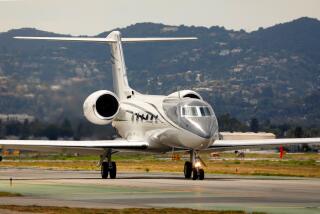Freedom of the Skies Is Costly
- Share via
The air collision between a single-engine private plane and an Aeromexico DC-9 over Cerritos has touched off a heated debate concerning the risks that private aircraft pose to themselves, to commercial aircraft and to people on the ground.
But in all the talk about restricting the landing and takeoff rights of private planes, or equipping them with better radar and collision-avoidance gizmos, hardly anyone has mentioned what might be the most efficient way to reduce the private-plane problem: getting rid of the subsidy that these aircraft receive from commercial airline passengers.
That’s right. The last time you bought an airline ticket you helped subsidize the Piper involved in the Cerritos crash and the roughly 220,000 other private planes in the general-aviation fleet. Here’s how:
Commercial and general-aviation craft alike depend on America’s federally operated air-traffic-control system. In fact, takeoffs and landings by general-aviation planes accounted for 64% of all operations handled by airport control towers in 1985. Major commercial airlines accounted for just 20%, even though they are responsible for more than 90% of all passenger miles flown. (The other users of the air traffic system were commuter lines, air taxis and military planes.) Private users included many small planes, but jets and turboprops owned by wealthy executives and big corporations were more typical.
Private planes pay a “user’s fee” for air-traffic services through a 12-cent-per-gallon tax on airplane gasoline and a 14-cent tax on jet fuel. But, according to the nonpartisan Congressional Budget Office, these taxes cover only about one-tenth of the government’s costs. The general-aviation lobby--”the NRA of the air,” as it is known in Washington--has proved to be a formidable opponent not only of tougher safety standards but also of higher user fees.
So airline passengers are left holding the bag. The 8% tax on air tickets is designed to cover the cost of the commercial airliners’ use of the system. That it does--and then some. According to the Congressional Budget Office, the ticket tax actually brings in 20% more than the cost of the services that airlines use--making up for part of what general aviation doesn’t pay.
The safety record of these subsidized private planes has been improving in some respects lately, but it’s still atrocious. In 1984 general aviation’s fatal-accident rate was 1.73 per 100,000 flying hours--123 times worse than the airlines’ rate. In the first seven months of this year there were 130 mid-air near-collisions involving airliners and non-airliners--up 30% over last year. And then there was Cerritos.
Private planes contribute to airport congestion, too. That keeps commercial flights waiting. At busy major airports in Los Angeles, Boston and Atlanta, private planes equipped with the necessary instruments to communicate with the control towers are perfectly free to take spots in front of airliners in the takeoff and landing queues, even during peak hours, as long as they get there first.
At “high-density” airports such as New York’s John F. Kennedy and Washington’s National, general-aviation craft are restricted to a quota of takeoff and landing “slots.” But there are still enough of them to add to the time that others would have to wait if there were no general-aviation planes. National, for example, reserves 12 of its 60 slots each hour for private planes.
Private planes rarely have to pay more than $100 for the privilege of landing at a major airport. They can land for free at Atlanta and Los Angeles, and private jets can touch down for just $5.28 in Washington. Such low rates tempt corporate planes to use major airports rather than less convenient reliever airports.
Of course general-aviation pilots should be better trained and have to carry better radar and collision-avoidance equipment. But these measures still would not solve the fundamental problem of too many planes cluttering the airspace. The best way to relieve this burden on already swamped air-traffic controllers is to cut the number of general-aviation planes in the air.
The general-aviation lobby bristles at outright restrictions on private planes, insisting on “freedom of the skies.” Fine. But let these planes pay for the privilege. No subsidies from anyone. The Congressional Budget Office estimates that this would cut their activity by 14% and save the government $2.9 billion over the next five years.
Freedom of the skies is a noble-sounding principle. But America’s limited supply of airways, airports and air-traffic controllers should be used to move the public as safely and cheaply as possible--not to cater to a relative handful of private fliers. Subsidizing prop planes and executive jets at the expense of commercial airline passengers is irrational, unfair and potentially dangerous.
More to Read
Inside the business of entertainment
The Wide Shot brings you news, analysis and insights on everything from streaming wars to production — and what it all means for the future.
You may occasionally receive promotional content from the Los Angeles Times.










